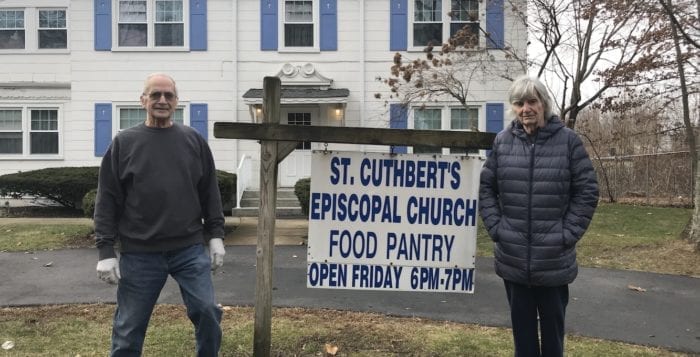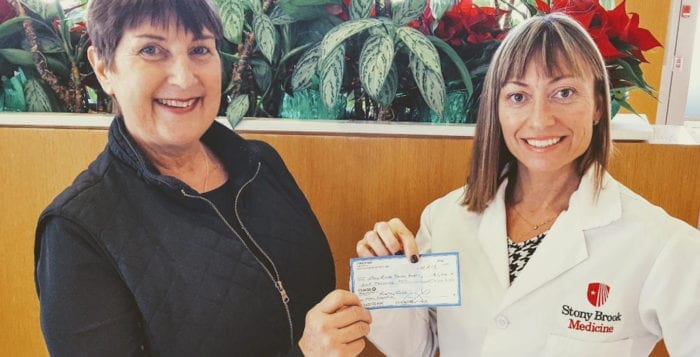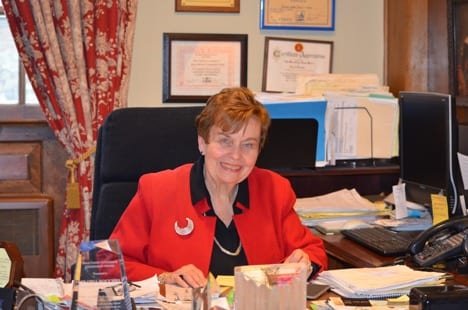By Rich Acritelli
“Every kid should have one Tom Judge as their teacher and coach within their lifetime.”
These words were recently stated by Comsewogue School District Superintendent Joseph Rella on the educational and coaching legacy of Tom Judge who is finally being recognized by the district after decades of working for the school and community. On Jan. 10, his name will adorn the high school wrestling room.
As a kid, the longtime resident of Mount Sinai lived in Manhattan Beach, Brooklyn. Judge’s father was a New York State police trooper and a veteran who was awarded the Purple Heart as a Navy gunner in the Pacific during World War II. After living in government housing that was provided to veterans, Judge’s father moved a family of nine children to a Levitt house in Hicksville. From his earliest years as a kid, Judge supported himself by working jobs as a roofer and pumping gas at a local Shell station.
Judge’s true athletic passion was displayed through his iron will to play baseball, football and wrestling. At Hicksville High School, Judge was a respected team leader who excelled at being a linebacker and halfback. While it was many decades since he played for the Comets, with a big smile, Judge has recalled how his football team defeated rival Farmingdale to win their conference. In the winter months, Judge was a devoted wrestler who competed at 167 and 191 pounds. In order to help his team win matches, Judge wrestled at a heavier weight, where he made a name for himself by placing in several tournaments.

After taking a year off after high school, Judge had a unique opportunity to attend college. Football coaches from South Dakota’s Yankton College held a recruiting picnic at Belmont State Park in Babylon. This school was interested in accepting Judge due to his reputation for being a competitive football player. Judge received an athletic scholarship and grant funding that was offered to him by this school. At Yankton, this kid from Nassau County demonstrated his versatility as a football player and a wrestler. Attending college with him was Robin Winkel, a native of Hicksville and a strong wrestler, who later proved to be an incredibly successful wrestling coach at the Rocky Point school district. Both men drove together from Hicksville to the wide-open lands of South Dakota where they met members of the Sioux tribe.
At Yankton, Judge was a leading wing back who was able to run the ball and block against the large defensive linemen. He also played with fellow Nassau County native Lyle Alzado. This aggressive and wild football player had a distinguished career with the Denver Broncos and the Oakland Raiders. Judge’s team won the tri-state football championship comprised of teams from Iowa, Nebraska and South Dakota, but the training conditions were not ideal, and he seriously hurt his ankle playing on a practice field that was formerly a cow pasture.
Judge’s youngest daughter, JoAnna, marveled at the concentration that her father had to play both football and wrestling at an extremely competitive level and still maintain his grades. JoAnna said her father has “firmly lead by example, and his energy is contagious during every endeavor.” While he was at this school to play sports, Judge has said he is immensely proud of his opportunity to earn a college degree that saw him major in physical education and sociology and minor in psychology.
As a kid, Judge was only a short train ride away from New York City, and as a college senior he completed his student teaching in a school that only had 200 children. He recalled most of these kids were farmers who had to endure the late winter flooding of the tributary waterways that flowed into the Missouri River. Judge has long enjoyed the finer aspects of the outdoors and he was able to hike through the beauty of the Black Hills near Yankton. Judge’s oldest daughter, Amanda, fondly remembered the family nature walks that were led by her father to “look for fox and deer in the fields by their house, and this respect of the outdoors has stayed with me ever since.”
For three years after his graduation in 1969, Judge taught physical education at the Tuckahoe School in Southampton. Around the same time Judge was hired as an assistant wrestling coach at Long Island University. In 1973, he was employed as a gym teacher at Comsewogue and he later earned his certificate to teach health from Stony Brook University.

Judge’s son, Brenden, identified how he constantly meets his father’s wrestlers out in the world, and they always mention the “positive lessons” that were taught by his father. Through his 23 years as a varsity wrestling coach, Judge constantly preached a team first mentality. Brenden said his father was a stickler in ensuring his team did not disrespect the colors of the school and that his athletes were expected to conduct themselves as “gentlemen.” As a superintendent and friend, Rella praised Judge’s genuine approach in “absolutely refusing to allow any kid to fail and teach them life lessons in education and sports.” Up until he was 55 years old, Judge could be seen running, doing calisthenics, staying active and otherwise being a model for the students around him.
Judge had the opportunity to coach and mentor one of the finest wrestlers and football players ever to be produced on Long Island. Adam Mariano was a two-time New York State champion who was also a Hanson Award winner in football. In this school year, Judge has come out of retirement to coach the junior varsity team at Comsewogue, and his current athletes have been curious to see his coaching presence around Mariano in YouTube videos that still show the strength of this legendary competitor. While wrestling is extremely difficult and grueling, the big smile, laugh and kind demeanor of Judge always made the rigors of this sport easier to handle for his athletes over the years. The character of Judge has been instrumental in turning out graduates who have been productive within all aspects of society. Because of his work within the school community, the Comsewogue wrestling team will name its room after coach Tom Judge Jan. 10 with a plaque listing all of the league, county and state winners from this school.
According to his children, Judge always pronounces his love for his wife Barbara and the success that she has achieved as a gymnastics coach at Mount Sinai School District. The Judges enjoy watching their grandson, Jaden, who is also the third generation of this family to learn how to wrestle. Armed with a warm personality, Judge practically glows about the accomplishments of his children, and he said he is elated Brenden just completed his training to become an occupational therapist. Over the last five years, he has watched JoAnna, a former state champion and respected gymnast at the University of Rhode Island, to teach and move on to coach gymnastics at Commack School District.
Judge has never lost his love of nature and to this day enjoys visiting his daughter, Amanda, a social studies teacher at Wappinger Falls, where they continue their pursuit to discover the natural wonders of upstate New York.























 The organization’s programs on the Underground Railroad and the Culper Spy Ring have earned national acclaim. Performances at its historic sites reach virtual audiences near and far — from schools in Setauket to classrooms in Louisiana, Quebec and Panama. A new event in 2019 entitled The Courageous Women of the Revolutionary War will showcase the unsung stories of four women involved in George Washington’s spy ring.
The organization’s programs on the Underground Railroad and the Culper Spy Ring have earned national acclaim. Performances at its historic sites reach virtual audiences near and far — from schools in Setauket to classrooms in Louisiana, Quebec and Panama. A new event in 2019 entitled The Courageous Women of the Revolutionary War will showcase the unsung stories of four women involved in George Washington’s spy ring.


